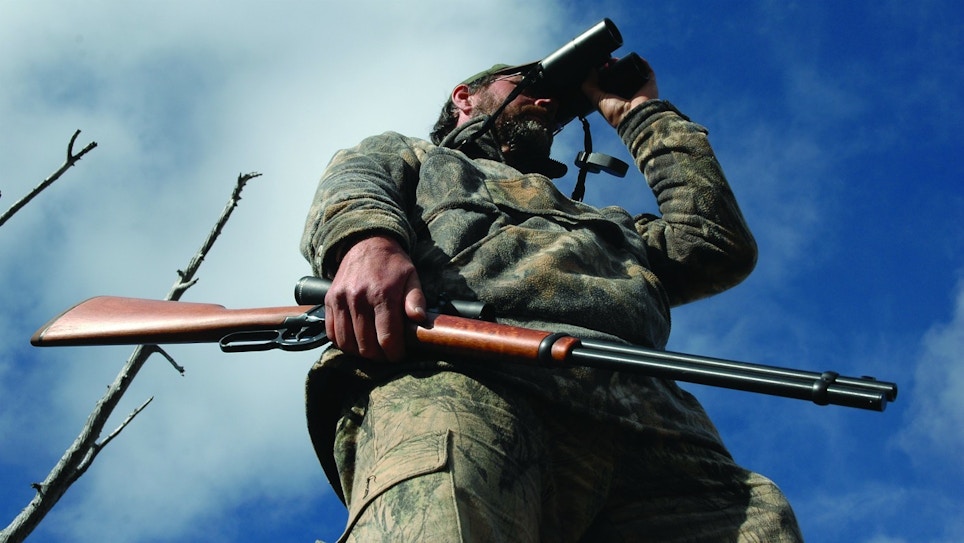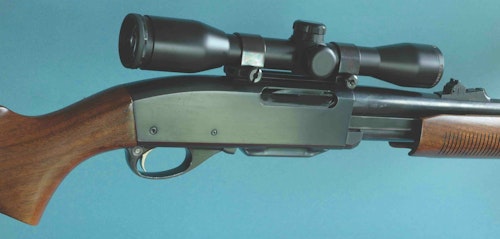She was lovely. Lean, with cat-like grace and a sparkle that wasn’t cheap. A soul to match her profile. Every fellow crowding around wanted her, but only one took her home.
She sold for $198. In 1964, I might as well have lusted for a Maserati as for a 1952 Mannlicher-Schoenauer carbine.
I’ve since admired others. Her forebears had the genes. The Model 1903 M-S in 6.5x54 endeared herself to hunters and explorers from Alaska to Zambia. Bluff-nosed solids, long as pencils, took down game as big as elephants.
The 150-year-old Austrian firm Steyr still makes carbines, though the Mannlicher-Schoenauer labels are retired (the two men were engineers, not corporate chiefs). Once, with a svelte Steyr-Mannlicher in a European forest, I spied three forest hogs scooting through the undergrowth. They paused 80 steps away. Bang! Bang! Bang! The full-stocked 9.3x62 laid all of them low, seemingly on its own.
The Carbine Is Born
“Carbine” derives from the French “carabine,” an arm borne by cavalry. The term has outlasted the horse and muzzleloader in battle. On both sides of the Atlantic, hunters and soldiers came to use it as shorthand for short-barreled rifles. By the way, while Mannlicher-Schoenauer carbines famously featured full-length stocks, not all carbines do.
By modern standards, the first short cavalry guns were quite long. The U.S. Model 1842 was at once our last smoothbore musket and the first with interchangeable parts. The barrel of its offspring, the 1842 Short Rifled Musket for cavalry, measured 33 inches. A few years later the 1860 Spencer carbine had a 20-inch barrel. James Lee designed one of the first successful bolt-action carbines in 1878. Straight-grip 1882 Remington-Lee Military Rifles and carbines, like Sporting Rifles of the type, had slick-feeding detachable boxes. In 1887, Great Britain adopted the Lee, moving manufacture from Ilion, New York, to England. By then Remington’s 1870 Rolling Block Carbines in .50-70 had been issued to frontier cavalry.
John Browning’s brilliant lever-actions blessed Winchester in the 1880s and ‘90s. Nimble, quick-cycling, scabbard-friendly carbine versions became popular with hunters. As smokeless powder replaced black, the carbine sired the Short Rifle (capitals denoting sub-models, as opposed to generic types). The Short Rifle was a rifle with a carbine-length barrel. Winchester peddled both forms. The standard 26-inch barrel of the Model 1886, for example, could be ordered with the ‘86 carbine’s 22-inch barrel. Result: A compact rifle without barrel bands or the carbine’s lightweight barrel. A short rifle had a crescent butt-plate instead of the carbine’s S-shaped plate. These options came with Models 1892 and 1894 rifles, too. “Trapper” and other special versions had barrels shorter than those for carbines. Current reproductions for Browning/Winchester by Miroku in Japan, and from top Italian makers sold by Cimarron and other brands, have retained these designations.
Had I taken care with the first shot, I’d not have needed the fourth. But when the buck rocketed from underfoot, I almost lost my grip on the Winchester. Fumbling for hammer, trigger, then lever, I fired fast, because the buck was moving fast. But the close, thick brush made him seem faster. Tightening the lead on the third shot, I called hits. Saplings swallowed the deer. It died shortly thereafter.
Fifty-percent shooting deserves no plaudits. But a quick rifle in tight places can salvage abysmal marksmanship. That lively, iron-sighted .30-30 hung with the deer and kept chattering. Redemption.
Winchester’s Model 1894 was just one of a flock of agile repeaters trailing smokeless powders into the 1890s. Marlin built some of the best, courtesy Lewis Hepburn, who had joined the firm in 1886 after 15 years at Remington. Hepburn applied his talent to Marlin lever-action Models 1888, 1889, 1891, 1892, 1893, 1894, 1895 and 1897. Alas, in 1910 a broken hip caused by a fall on ice would later claim his life. Marlin’s 1893 competed with Winchester’s 1894, the Marlin 1894 with the Winchester 1892. These and the 1895 Marlin in .45-70 all appeared in carbine form. Longer barrels remained popular enough that in 1901, Marlin felt compelled to cut the price of its 5.5-pound 1894 Carbines to $10.40. By the 1950s, after Marlin’s 1893 had evolved into the 36, then the 336, 20-inch barrels had become popular across this spectrum. Whitetail hunters comprised a big piece of the hunting market. They favored the light weight, natural balance and wand-like pointing qualities of carbine-length barrels. The heavier, more powerful 71 Winchester came in carbine form, too.
In 1912, amidst a tide of popular lever rifles, Remington fielded its slide-action Model 14 in .25, .30, .32 and .35 Remington. The “R” carbine version ($16.75) had an 18.5-inch barrel — as did the 14½ R in .38-40 and .44-40, replaced by the Model 25 in 1922. An improved 141 R arrived in 1936, the newly minted 760 with rotating bolt in 1958. The 760 Carbine gained celebrity in the hands of Maine’s Benoit family, renowned deer hunters. In 1961, Remington announced a carbine version of its 742 autoloader. Ruger’s cute self-loading .44 Magnum Deerstalker, with 18.5-inch barrel, was advertised as a carbine. It cost $108 at its 1959 introduction, one of the many rifles I couldn’t afford as a teenager.
As Austria’s Mannlicher-Schoenauer Carbines of 1950, ’52, ’56 and ’61 were following pre-WW I models into oblivion, Remington was building its first bolt-action carbine since the Depression-era 30R. The Model 600 had an 18.5-inch barrel, a dog-leg bolt handle and a ventilated rib. The 660, with 20-inch barrel minus a rib, replaced it after 4 years and lasted three more, until 1971. Magnum versions of the 600 and 660 in .350 Remington, with laminated stocks, soon brought inflated prices.
Remington’s 6-pound Model Seven with 18.5-inch barrel arrived in 1983. It whelped the Alaska Wilderness Rifle in 7mm and .300 Short Action Ultra Mags. In Idaho’s wilderness, I carried an AWR and probably shot the first elk taken with the .300 SAUM. A Model Seven CS in .308 also had a nose for elk.
Other carbines have crossed my path: an 1896 Swedish Mauser in 6.5x55, a Savage 1899 in .303 Savage, a Winchester 53 in .44-40. More recent models include Marlin 336s, a CZ 557, a couple of Ruger No. 1s.
Rifle vs. Carbine
Distinctions between “rifle” and “carbine” have blurred with the advent of short barrels threaded for suppressors. Also, barrels on bolt rifles have shrunk from the 24 inches standard in the 1950s (Savage 110, Remington 721, Winchester 70) to 22 inches for many chamberings. Hunters could get a Model 70 during its first decade with an abbreviated 20-inch barrel. This rare variation has been called a carbine but was not so labeled by Winchester. From 1969 to 1971 the firm built a Model 70 Mannlicher full-stocked rifle with 19-inch barrel. Again, no Carbine label. In 1984 Winchester did trot out a Lightweight Carbine (20-inch). Meanwhile, Remington had installed a 20-inch barrel on its first Model 700 rifles. Two inches were added later. Oddly, the Savage 99E Carbine introduced in 1960 wore a 22-inch barrel; but the 99H rifle that preceded it by 55 years featured a 20-inch.
Post-Korean War autoloaders further confuse the picture. John Garand’s M1 rifle that served the U.S. and its WW II allies is much bigger and more potent than the M1 Carbine, designed to give support staff and vehicle crews a compact arm with greater effective reach than the 1911 pistol. After the armed services adopted the M16, Colt stuck with the Carbine moniker for 16-inch barrels. Other manufacturers decided this was “rifle” length for AR-style autos. But Remington lists its 18-inch R-15 VTR Predator as a carbine. Ruger has cataloged its Mini Thirty with 16-inch barrel as a rifle; in its M77 Hawkeye series Ruger uses “Compact” to describe 16.5-inch-barreled bolt guns.
Arbitrarily, I consider carbine an appropriate label for any rifle with a barrel 20 inches or shorter. One of my favorites is a full-stocked Ruger No. 1 RSI in .303 British. In SMLE rifle this grand cartridge killed my first whitetail. The rimmed, generously tapered hull suits dropping-block actions; modest case capacity and .311 bullets are comfy in short barrels. At just under 8 pounds with its 14-ounce scope, my No. 1 has heft, but Ruger blessed it with that elusive union of balance and form that makes rifles behave as if alive. And it has plenty of reach. One Dakota buck fell to a 180-yard poke after a careful sneak. But well aimed, the little Ruger could have toppled that deer at 300.
Lust for a carbine? Before you grab the hacksaw, or more prudently visit a gunsmith, consider the trade-offs. Short barrels sap bullet speed. A carbine won’t settle as quickly or completely as a heavier rifle when you aim. You’ll get more recoil, blast and muzzle jump, slowing your recovery. If, like me, you’re a dinosaur sweet on iron sights, you’ll get less precision from the abbreviated sight radius. And consider resale value. I once bought a pre-war Model 70 with a bobbed barrel. The saw had bled 4 inches and several hundred dollars from that Winchester.
Not that all such butchery is evil. In another life, before learning I lacked rudimentary skills with machinery, I did some commercial gun work. Back then, 1917 Enfields fetched about $40. These heavy, ungainly rifles begged an overhaul. I trimmed a pal’s Eddystone to a manageable 7.5 pounds. It looked better and handled more nimbly. And after a long day on the mountain, my partner tripped into camp fresh enough to make supper.
You don’t need a 1952 Mannlicher-Schoenauer to love carbines.
Sidebar: Best Carbines for Deer Hunters?
Among traditional production-class carbines, Marlin’s 336C in .30-30 and .35 Remington is my pick, at $654. Top of the short-action roster is Winchester’s 1892 Carbine, .44-40 and .44 Magnum ($1,070) — though Italian reproductions of early Winchesters, from Cimarron, rank high, too. Fetching bolt rifles include C-Z’s petite 527 Carbine, with iron sights and 18.5-inch barrel, in 7.62x39, for $752. Three bolt-actions with 20-inch, sight-free barrels: Remington’s Model Seven Stainless H-S, Savage’s 11/111 Lightweight Hunter and Tikka’s T3X Compact — all in .308 and 6.5 Creedmoor (plus other chamberings). Mossberg’s value-priced Patriot Predator has a suppressor-friendly 16.25-inch barrel in .450 Bushmaster.
Images by Wayne van Zwoll









